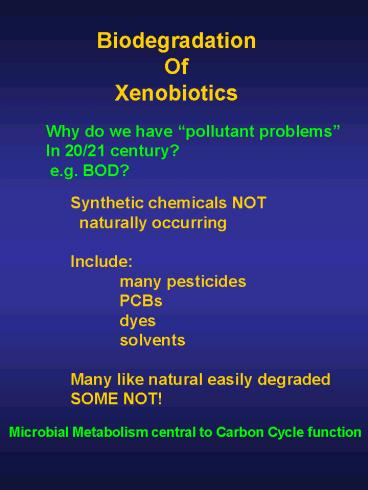Biodegradation - PowerPoint PPT Presentation
1 / 19
Title:
Biodegradation
Description:
Biodegradation. Of. Xenobiotics. Synthetic chemicals NOT ... DDT : Microbial Biodegradation Model. IUPAC Name: 1,1,1-trichloro-2,2-bis-p-chlorophenylethane ... – PowerPoint PPT presentation
Number of Views:756
Avg rating:3.0/5.0
Title: Biodegradation
1
Biodegradation Of Xenobiotics
Why do we have pollutant problems In 20/21
century? e.g. BOD?
Synthetic chemicals NOT naturally
occurring Include many pesticides PCBs dyes
solvents Many like natural easily degraded SOME
NOT!
Microbial Metabolism central to Carbon Cycle
function
2
Under favorable conditions ALL naturally
occurring organics are degraded Actually
respired to mineral elements Evidence no vast
accumulations Principle of Microbial
Infallibility Martin Alexander Why? Evolution
of biopolymers is slow microbial catabolism
parallels SO What can microbes do? What do
they need? How can we use them?
3
Needs Nutrients Energy Environment Enzymes S
O oil mineralization May lack N, P Has energy
hydrocarbon Temperature Issues Enzymes OK
4
(No Transcript)
5
R-CH2-CH3 NADPH2 ? Monooxygenases need
O2 R-CH2-CH2-OH NADP H2O Then beta
oxidation (pix) cleaving 2 Carbons at a time and
leaving the alcohol. Likely also anaerobic by
direct dehydrogenation Through secondary
alcohol and aldehyde to carboxylic acid
6
Beta Oxidation Of Fatty Acids
7
R-CH2-CH3 NADPH2 ? Monooxygenases need
O2 R-CH2-CH2-OH NADP H2O Then beta
oxidation cleaving 2 Carbons at a time and
leaving the alcohol. Likely also anaerobic by
direct dehydrogenation Through secondary
alcohol and aldehyde to carboxylic acid
8
AND subterminal oxidation
9
Aromatic ring cleavage
10
- But xenobiotics foreign to nature
- Some resist mineralization
- Recalcitrant (Alexander)
- Microbes not degrade or only slowly
- Unusual substitutions (Cl, Br)
- Unusual bonds (tertiary, quaternary)
- Condensed aromatic rings
- Large molecular size
- Fail to induce enzymes
- Fail to enter cells
- Insoluble in water
- Toxic
- Degrade to more stable compounds
11
(No Transcript)
12
(No Transcript)
13
(No Transcript)
14
DDT Microbial Biodegradation Model IUPAC
Name 1,1,1-trichloro-2,2-bis-p-chlorophenylethan
e Structure
Water Solubility ltlt (ppm) Kow
HIGH Adsorption gtgt Kd Koc
HIGH Vaporization gt due to large air
volume Bioaccumulation gtgt BCF
HIGH Degradation ltlt due to
structure halogens Co-metabolism gt gt gt gt CO2
and H20
15
Egg Shell Thickness
Eggshell Thinning affect endocrine system
and shell deposition Ratcliff Science 1969
16
Food Web Biomagnification
Low water solubility, persistent Not excreted,
not degraded
17
DDT recalcitrant C-halogen bonds BUT can be
mineralized in vitro and invivo
(Alexander) Dechlorinate to DDD Dehydrochlorinate
to DDE
18
Science 1 May 1998Vol. 280. no. 5364, pp. 722 -
724DOI 10.1126/science.280.5364.722Prev Table
of Contents Next Reports Reductive
Dechlorination of DDE to DDMU in Marine Sediment
Microcosms John F. Quensen III, Sherry A.
Mueller, Mahendra K. Jain, James M. Tiedje DDT
is reductively dechlorinated to DDD and
dehydrochlorinated to DDE it has been thought
that DDE is not degraded further in the
environment. Laboratory experiments with
DDE-containing marine sediments showed that DDE
is dechlorinated to DDMU in both methanogenic and
sulfidogenic microcosms and that DDD is
dehydrochlorinated to DDMU three orders of
magnitude more slowly. Thus, DDD does not appear
to be an important precursor of the DDMU found in
these sediments. These results imply that
remediation decisions and risk assessments based
on the recalcitrance of DDE in marine and
estuarine sediments should be reevaluated.
19
Hydrogenomonas O2 Then Arthrobacter O2 Yields
para chlorophenyl acetic acid Co-metabolism
Focht and Alexander No carbon or energy
enzymes happen to work.































